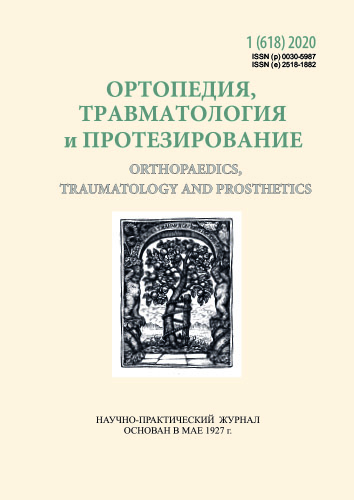Crural tissues histopathology and clinical-morphological correlations in patients with traumatic osteomyelitis, combined with trophic disorders
DOI:
https://doi.org/10.15674/0030-59872020154-65Keywords:
traumatic osteomyelitis, trophic disorders, tibia, soft tissues, clinical indicators, morphometric indicators, correlationsndencesAbstract
Detailed analytical study of pathologic changes that would display features of the damaged tissues condition at the traumatic osteomyelitis (TO) combined with trophic disorders are important for treatment tactics.
Objective: to determine the frequency and correlations between clinical and morphometric parameters on the basis of the graded morphometric analysis of changes that occur in the injured tissues in patients with tibia TO and crural tissues with trophic disorders.
Methods: fragments of the damaged crural tissues (bone, soft tissues, skin) from 38 patients with TO were studied. We used: clinical examination and determined the degree of trophic disorders; visualising methods, histologic research with morphometric parameters estimations, the analysis of correlations between clinical and morphometric parameters.
Results: trophic disorders in extremity tissues (bone, soft tissues, muscles, skin) which were observed at TO, represented a complex of pathological changes: ischemic, necrotic, dystrophic, atrophic, inflammatory, reparative which combined in various proportions. The closest correlations of morphometric parameters were found with such clinical indicators as «gender», «type of fracture» and «term of the latest debridement».
Conclusions: аt TO of the tibia, combined with trophic disorders, some correlations between clinical and morphometric parameters of involved extremity tissues were found. The revealed dependences are important for evaluation of tissue damage grade by known clinical indicators values that should promote predicting of disease course and its consequences, planning of medical interventions.
References
- Boehm, E. (1986). Chronische posttraumatische Osteomyelitis. Hefte Unfallheilkunde, 176, 123
- Tsukayama, D. T. (1999). Pathophysiology of posttraumatic osteomyelitis. Clinical Orthopaedics and Related Research, 360, 22-29. https://doi.org/10.1097/00003086-199903000-00005
- Grigorovsky, V. V. (2013). Aspects of pathomorphology and nomenclature in the modern classification of nonspecific osteomyelitis. Orthopedics, traumatology and prosthetics, 3, 77-87. DOI: http://dx.doi.org/10.15674/0030-598720133777-87. [in Russian]
- Sanders, J., & Mauffrey, C. (2013). Long bone osteomyelitis in adults: Fundamental concepts and current techniques. Orthopedics, 36(5), 368-375. https://doi.org/10.3928/01477447-20130426-07
- Beck-Broichsitter, B. E., Smeets, R., & Heiland, M. (2015). Current concepts in pathogenesis of acute and chronic osteomyelitis. Current Opinion in Infectious Diseases, 28(3), 240-245. https://doi.org/10.1097/qco.0000000000000155
- Bingyuan, L., Kai, H., & Huajun, Y. (2017). Surgical treatment for 76 patients with posttraumatic osteomyelitis of the Tibia. Biomedical Research, 28(8), 3585–3588
- Wang, X., Yu, S., Sun, D., Fu, J., Wang, S., Huang, K., & Xie, Z. (2017). Current data on extremities chronic osteomyelitis in Southwest China: Epidemiology, microbiology and therapeutic consequences. Scientific Reports, 7(1). https://doi.org/10.1038/s41598-017-16337-x
- Rosenberg, A. E., & Khurana, J. S. (2016). Osteomyelitis and osteonecrosis. Diagnostic Histopathology, 22(10), 355-368. https://doi.org/10.1016/j.mpdhp.2016.09.005
- Junka, A., Szymczyk, P., Ziółkowski, G., Karuga-Kuzniewska, E., Smutnicka, D., Bil-Lula, I., Bartoszewicz, M., Mahabady, S., & Sedghizadeh, P. P. (2017). Bad to the bone: On in vitro and ex vivo microbial Biofilm ability to directly destroy colonized bone surfaces without participation of host immunity or Osteoclastogenesis. PLOS ONE, 12(1), e0169565. https://doi.org/10.1371/journal.pone.0169565
- Ivanov, Yu. I., & Pogorelyuk, O. N. (1990). Statistical processing of the results of biomedical research on microcalculators according to programs. Moscow: Medicine. [in Russian]
- Antony, S., & Farran, Y. (2016). Prosthetic joint and orthopedic device related infections. The role of Biofilm in the pathogenesis and treatment. Infectious Disorders - Drug Targets, 16(1), 22-27. https://doi.org/10.2174/1871526516666160407113646
- Filippenko, V. A., Marushchak, A. P., & Bondarenko, S. E. (2016). Periprosthetic infection: diagnosis and treatment. Part 1 (literature review). Orthopedics, traumatology and prosthetics, 2, 102-110. DOI: 10.15674/0030-598720162102-110. [in Russian]
- Wang, S., Yin, P., Quan, C., Khan, K., Wang, G., Wang, L., … & Tang, P. (2017). Evaluating the use of serum inflammatory markers for preoperative diagnosis of infection in patients with Nonunions. BioMed Research International, 2017, 1-5. https://doi.org/10.1155/2017/9146317
- George, J., Kwiecien, G., Klika, A. K., Ramanathan, D., Bauer, T. W., Barsoum, W. K., & Higuera, C. A. (2016). Are frozen sections and MSIS criteria reliable at the time of reimplantation of two-stage revision arthroplasty? Clinical Orthopaedics and Related Research, 474(7), 1619-1626. https://doi.org/10.1007/s11999-015-4673-3
- Tiemann, A., Hofmann, G. O., & Krukemeyer, M. G. (2014). Histopathological Osteomyelitis Evaluation Score (HOES) — an innovative approach to histopathological diagnostics and scoring of osteomyelitis. GMS Interdisciplinary Plastic and Reconstructive Surgery, 3, Article ID: Doc08. DOI: 10.3205/iprs000049
- Grigorovsky, V. V., Gritsay, M. P., & Kolov, G. B. (2016). Morphological parameters of the condition of tissues adjacent to metal plates, with infectious complications of osteosynthesis, frequency and correlations. Bulletin of Orthopedics, Traumatology, prosthesis, 2, 17-24. [in Ukrainian]
- Khitrov, N. K. (1995). Nervous trophism and inflammation. A guide for doctors. Мoscow: Medicine. [in Russian]
- Serov, V.V. (1999). General pathological approaches to the knowledge of the disease. Мoscow: Medicine. [in Russian]
Downloads
How to Cite
Issue
Section
License
Copyright (c) 2020 Valeriy Hryhorovskyi, Mykola Hrytsai, Vasyl Tsokalo, Hennadiy Kolov, Anastasiia Hrygorovska

This work is licensed under a Creative Commons Attribution 4.0 International License.
The authors retain the right of authorship of their manuscript and pass the journal the right of the first publication of this article, which automatically become available from the date of publication under the terms of Creative Commons Attribution License, which allows others to freely distribute the published manuscript with mandatory linking to authors of the original research and the first publication of this one in this journal.
Authors have the right to enter into a separate supplemental agreement on the additional non-exclusive distribution of manuscript in the form in which it was published by the journal (i.e. to put work in electronic storage of an institution or publish as a part of the book) while maintaining the reference to the first publication of the manuscript in this journal.
The editorial policy of the journal allows authors and encourages manuscript accommodation online (i.e. in storage of an institution or on the personal websites) as before submission of the manuscript to the editorial office, and during its editorial processing because it contributes to productive scientific discussion and positively affects the efficiency and dynamics of the published manuscript citation (see The Effect of Open Access).














